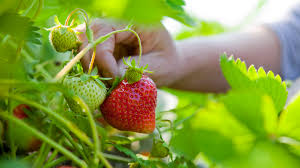Strawberries are a beloved fruit, known for their vibrant color, sweet taste, and versatility in a variety of dishes. Growing them at home can be both rewarding and fun, especially when using creative methods like 5L plastic bottles. This eco-friendly and space-saving technique can lead to an abundant strawberry harvest, even if you have limited gardening space. Here’s a detailed guide on how to cultivate strawberries in plastic bottles and enjoy a bountiful supply of fresh berries.
1. Choosing the Right Containers
5L plastic bottles are a fantastic option for container gardening. They are often discarded as waste, making them an environmentally friendly choice. Start by cutting off the top part of each bottle, leaving the bottom half to serve as the growing container. This simple modification turns a basic plastic bottle into a self-contained gardening environment.
2. Preparing the Soil
Strawberries thrive in well-draining soil that is rich in organic matter. A mixture of potting soil and compost in equal proportions provides the ideal growing medium. Fill the plastic bottles with this soil mix, making sure it is light and fluffy. Proper drainage is essential, as strawberries do not like sitting in waterlogged soil. You may also want to add a layer of small stones or gravel at the bottom of the bottle for additional drainage.
3. Selecting the Right Strawberry Varieties
When it comes to strawberries, there are three main types: June-bearing, everbearing, and day-neutral. For a continuous harvest throughout the growing season, it’s best to choose everbearing or day-neutral varieties. These types of strawberries produce fruit several times a year. Alpine strawberries, known for their compact size and sweet taste, are also perfect for container gardening.

4. Planting Your Strawberries
Once your containers are prepared, it’s time to plant the strawberries. Place young plants or strawberry runners in the bottles, making sure the crown (the part where the leaves meet the roots) is slightly above the soil surface. Space the plants about 8-10 inches apart to ensure they have enough room to grow and spread. If you’re using bare-root plants, soak them in water for a few hours before planting to encourage healthy growth.
5. Providing Sunlight
Strawberries need plenty of sunlight to thrive. Aim to place your containers in a sunny spot that receives at least 6-8 hours of direct sunlight daily. Sunlight is essential for stimulating flowering and fruit production, so choose a location that gets ample sun throughout the day.
6. Watering Your Plants
Strawberries in containers require consistent moisture. Since containers tend to dry out more quickly than garden soil, regular watering is crucial—especially during hot, dry weather. However, avoid overwatering, as soggy soil can lead to root rot. Check the moisture level frequently by sticking your finger into the soil; it should feel moist but not saturated.
7. Fertilizing for Maximum Growth
Strawberries are heavy feeders, meaning they need a steady supply of nutrients for optimal growth. Apply a balanced, slow-release fertilizer every 4-6 weeks during the growing season. This will help promote healthy plant growth and encourage abundant fruit production. Be sure to follow the manufacturer’s instructions to avoid over-fertilizing, which can harm your plants.
8. Managing Pests and Diseases
Strawberries can be prone to pests such as aphids, slugs, and snails, as well as fungal diseases like gray mold. Regularly inspect your plants for signs of pests or disease. If you spot any issues, treat them with organic pest control methods, such as neem oil or insecticidal soap. Good air circulation and proper spacing between plants can also help prevent fungal infections.
9. Pruning and Controlling Runners
To encourage more vigorous growth and increase your strawberry harvest, prune any excess runners. These are the long stems that grow from the main plant and can sap energy from fruit production. By trimming them back, you allow the plant to focus its energy on growing fruit. This will lead to healthier plants and a more productive harvest.
Enjoy Your Homegrown Strawberries
By following these steps, you’ll be able to grow a flourishing strawberry garden in 5L plastic bottles. This method is not only cost-effective and space-efficient but also allows you to enjoy fresh, homegrown strawberries year-round. Whether you’re a beginner or an experienced gardener, this innovative approach is sure to provide a satisfying and fruitful gardening experience.
Fun Fact: Vivipary in Strawberries
Did you know that strawberries can exhibit a phenomenon called vivipary? This is where seeds begin to germinate while still attached to the parent plant. This rapid propagation method allows strawberry plants to reproduce quickly, helping ensure that new plants are ready to grow even before they detach from the original plant. It’s a fascinating testament to the adaptability and prolific nature of strawberries.
With just a few simple steps and the right care, you’ll be enjoying fresh, homegrown strawberries from your own eco-friendly containers. Happy gardening!
